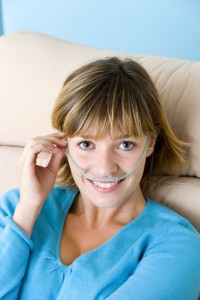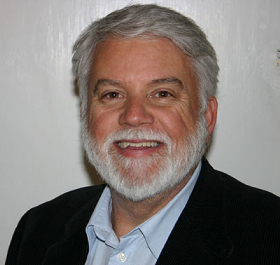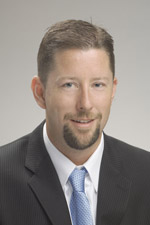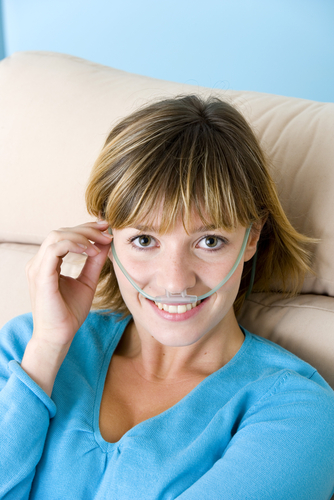 If you ask the average person what’s the third-leading cause of death in the U.S. – the answer is unlikely to be: “Chronic Obstructive Pulmonary Disease.” Nevertheless, according to the Centers for Disease Control and Prevention, COPD ranks third (138,080) after heart disease (597,689) and cancers (574,743). COPD is also the fourth-leading cause of mortality (stroke is currently third, but COPD is projected to overtake it by 2020), and second only to chest pain as a medical cause for emergency room visits in Canada, with 1.3 million “reported” (diagnosed) cases of COPD in Canada, and in excess of 4 million Canadians with a lung function indicative of this disease. Reportedly, a survey in the province of Ontario predicted that 25 percent of patients over the age of 35 will be diagnosed with COPD, which is also the number two cause of death in China, with more than 40 million afflicted. The American Lung Association notes that COPD is also a major cause of disability, and while some 12 millions Americans have a formal COPD diagnosis. An estimated 12 million more people may have the disease and go undiagnosed. Approximately 23 million men and women in the United States have COPD.
If you ask the average person what’s the third-leading cause of death in the U.S. – the answer is unlikely to be: “Chronic Obstructive Pulmonary Disease.” Nevertheless, according to the Centers for Disease Control and Prevention, COPD ranks third (138,080) after heart disease (597,689) and cancers (574,743). COPD is also the fourth-leading cause of mortality (stroke is currently third, but COPD is projected to overtake it by 2020), and second only to chest pain as a medical cause for emergency room visits in Canada, with 1.3 million “reported” (diagnosed) cases of COPD in Canada, and in excess of 4 million Canadians with a lung function indicative of this disease. Reportedly, a survey in the province of Ontario predicted that 25 percent of patients over the age of 35 will be diagnosed with COPD, which is also the number two cause of death in China, with more than 40 million afflicted. The American Lung Association notes that COPD is also a major cause of disability, and while some 12 millions Americans have a formal COPD diagnosis. An estimated 12 million more people may have the disease and go undiagnosed. Approximately 23 million men and women in the United States have COPD.
“COPD,” like “cancer,” terminologically encompasses a range of conditions, but generally speaking refers to permanent lung damage that gets worse over time. The disease can affect patients’ airways, air sacs or both The disease can affect patients’ lung airways, air sacs or both. The two most prevalent forms of COPD are chronic bronchitis and emphysema. Both cause airway blockage, resulting in shortness of breath, chronic productive coughing that produces large amounts of mucus, chest tightness and/or wheezing and other symptoms. Laboring to breathe can limit activity, diminish quality of life and put extra strain on the heart.
COPD typically involves a combination of emphysema and chronic bronchitis, both treatment-resistant conditions, and is most commonly associated with smoking. According to the Centers for Disease Control, CDC that some 434,000 people die annually in the U.S. from smoking related illness, and the American Lung Association estimates that more than 12.7 million adults in the US were afflicted with COPD in 2011.
Millions of people globally suffer from chronic lung diseases such as COPD, severe asthma, cystic fibrosis and lung cancer, all of which result in low blood oxygen levels and severely limit daily activity. The problem continues to grow.
[adrotate group=”3″]
ieCrowd’s Emerging Novel COPD Technologies
ieCrowd, a discovery-to-market commercialization platform for developing innovations with potential to solve global challenges, this week announced plans to commercialize a new class of intelligent supplemental oxygen devices. Once commercialized, the devices will integrate new technologies for delivering demand-driven and efficient oxygen flow to people living with chronic lung diseases.
ieCrowd acquired the exclusive license for the innovation’s underlying technology from University of California, San Diego, where the first prototype had been developed to address significant inefficiencies in supplemental oxygen devices on the market today. The technology is being commercialized by Breathing Technologies Inc. (BTI), a new subsidiary company formed by ieCrowd.
 “Existing oxygen delivery devices make it challenging to accurately address an individual patient’s need for oxygen in real time,” says Stephen Abbott, ieCrowd’s Chief Discovery Officer. “Our oxygen therapy device is being designed to provide a new, real-world solution that automatically and intelligently optimizes and automates the oxygen delivery process. This could simplify the patient’s use of supplemental oxygen expanding mobility and range, encouraging movement and activity, and reducing costs – all of which are important pieces to improving quality of life for patients.”
“Existing oxygen delivery devices make it challenging to accurately address an individual patient’s need for oxygen in real time,” says Stephen Abbott, ieCrowd’s Chief Discovery Officer. “Our oxygen therapy device is being designed to provide a new, real-world solution that automatically and intelligently optimizes and automates the oxygen delivery process. This could simplify the patient’s use of supplemental oxygen expanding mobility and range, encouraging movement and activity, and reducing costs – all of which are important pieces to improving quality of life for patients.”
A human clinical trial of the device was just completed at the Pulmonary Rehabilitation Clinic at UC San Diego Medical Center. Publication of the results from the trial are pending. Funding for the trial was provided by the University of California Proof of Concept Program — an effort to bridge the gap from research to commercialization in what is sometimes called “the valley of death:” that is, the absence of an industry sponsor and the lack of funding to build a prototype of a product or service that could then be used to solicit investment for a new company or license a new product. By facilitating the successful commercialization of innovations to society, this initiative is expected to have a positive impact on California and the state’s economy.
Targeted to become the market’s first smart, adaptive oxygen delivery system, the ieCrowd device uses a patient’s real-time oxygen requirements, based on sensor feedback and computer algorithms, to establish a user’s oxygen demand. The innovation is being developed to meet a patient’s oxygen requirements based on changing demands throughout the day. Current systems deliver oxygen based on regulator presets and patient adjustments, often creating a burden to the patient, shorter tank life-cycles, limited mobility ranges, and imprecise therapy.
The technology’s development also includes plans to enable communication to mobile devices and the cloud for monitoring patient data generated by the device. Sharing of patient-generated data with an individual’s medical providers and others involved in treatment means the device could become an important element of the growing ecosystem of Internet of Things (IoT)-connected medical devices. Through this constant information sharing, ieCrowd believes medical and treatment providers will have a better understanding of unique patient needs and will be able to improve care while reducing costs accordingly.
Breathing Innovation Discovery and University Partnership
The device’s underlying technology was developed on the UC San Diego campus by David Lisher and co-inventor Dr. Steve Roberts, PhD EE. Mr. Lisher had been diagnosed with COPD and was seeking ways to expand mobility and quality of life that had been restricted by his limited lung capacity. Mr. Lisher, who has 30-40 percent lung capacity, uses a prototype daily that enables him to maintain an active lifestyle which includes golf and working on his ranch.
 “We are proud to have a premier research institution like UC San Diego become an Innovation Partner of ieCrowd,” says Amro Albanna, founding chairman and CEO of ieCrowd. “This is another great example of how working together we can transform promising discoveries into solutions that have significant potential to benefit the world.”
“We are proud to have a premier research institution like UC San Diego become an Innovation Partner of ieCrowd,” says Amro Albanna, founding chairman and CEO of ieCrowd. “This is another great example of how working together we can transform promising discoveries into solutions that have significant potential to benefit the world.”
“Making the value in this technology available to the millions of potential patients in the U.S. and  abroad is a fantastic outcome of UC San Diego’s research mission,” says David Gibbons, Assistant Director of Technology Transfer and IP, UC San Diego. “As with any successful university derived product, the benefits here include not only long-term revenue, but also the tangible positive impact universities can have on everyone, and connections to new people and institutions as the beneficial technology becomes an ambassador for the university.” Mr. Gibbons adds that “ieCrowd’s business model is a very good fit for a university technology transfer office. The university can maintain a focus on basic research and discoveries while ieCrowd builds a business around the innovation to commercialize the discovery for maximum impact in the global market.”
abroad is a fantastic outcome of UC San Diego’s research mission,” says David Gibbons, Assistant Director of Technology Transfer and IP, UC San Diego. “As with any successful university derived product, the benefits here include not only long-term revenue, but also the tangible positive impact universities can have on everyone, and connections to new people and institutions as the beneficial technology becomes an ambassador for the university.” Mr. Gibbons adds that “ieCrowd’s business model is a very good fit for a university technology transfer office. The university can maintain a focus on basic research and discoveries while ieCrowd builds a business around the innovation to commercialize the discovery for maximum impact in the global market.”
Founded in 2010, Innovation Economy Corporation’s (DBA ieCrowd) mission is to transform breakthrough life and health discoveries into solutions capable of solving global challenges — a team of entrepreneurs, scientists, public health experts and business leaders who say they are passionately seeking to solve the world’s biggest challenges. With a focus on global life and health innovations, ieCrowd are building lasting partnerships with leading research institutions, federal agencies, non-profits, foundations, entrepreneurs, and innovators — all of whom make up the ieCrowd ecosystem designed to accelerate, expand, and deliver innovative solutions to market.
ieCrowd transforms breakthrough life and health discoveries into disruptive, market-driven solutions to global challenges. They work with top-tier research universities to identify promising discoveries which are developed and led to market by a team of experienced entrepreneurs, scientists and business leaders, and are developing a network of global market partners each positioned to launch future products and technologies to market. The crowd plays an integral role in each stage of ieCrowd’s mission to solve global challenges — from crowd-sourced innovations to crowd-funding, and crowd-supported product development to crowd-sourced market solutions. The crowd expands access to innovations, expertise and resources. Working together, they affirm creating social and economic impact for good.
ieCrowd begins by selecting cutting-edge scientific and technological breakthroughs that can scale rapidly and have significant impact on the lives of people around the world. They mobilize a business infrastructure that optimizes the rapid development of these disruptive technologies into solutions or solution platforms in 18-36 months. ieCrowd’s infrastructure is optimized for building high-growth, disruptive products, and shared across all ieCrowd solutions maximizing efficiency and impact and minimizing friction and costs. Products will be launched to a global market through a network of health and medical industry partners.
For more information about ieCrowd visit:
www.iecrowd.com
and
http://iecrowd.com/our-company#sthash.lNz4HIEY.dpuf
Sources:
ieCrowd
Centers for Disease Control and Prevention
American Lung Association
University of California, San Diego
COPD Canada
Image Credits:
ieCrowd
University of California, San Diego

